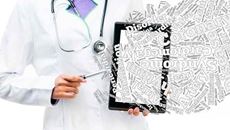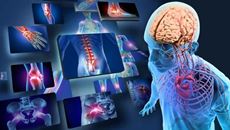- Delivery Method Online
- Professional Certificate
- 24hrs Suggested Study Time
- 3 Months Access
- Tutor Support
- Study On Any Device
- 5295 Students
Medical Transcription

Learn how to transcribe the medical reports most often used in healthcare today, and discover how to get started and advance as a medical transcriptionist.
Take your first step toward a lucrative career as a medical transcriptionist! In this course, you'll learn how to transcribe the most common medical reports used in both inpatient and outpatient settings. We'll review a lot of the grammar you might have forgotten since high school and apply it to the reports. This knowledge will help prepare you to work almost anywhere in the medical field—doctors' offices, clinics, public health facilities, and hospitals. With this foundation, you'll be set to advance your education so you can work as a subcontractor for a company that outsources transcription, or you can eventually even take on your own clients—all from the comfort of your own home.
We'll go through each of the nine main report types—their formatting requirements, the components of each one, and how they are used in the clinical setting. We'll review grammar points in every lesson, pointing out important elements that will make your reports perfect. You'll also gain important clinical knowledge of major disease processes that are essential to enhance your skill as a medical documentation specialist.
Along the way, we'll download a free transcriber that you'll use to listen to dictation, and we'll cover how to use it to produce the reports in your word processor. These hands-on exercises will give you the practice you'll need to determine if this field is for you. We'll also go through the options you'll have now and in the future by developing the skills of a medical transcriptionist. By the end of this course, you'll know the basic report types, have clinical knowledge of major diseases, be able to correct grammar from dictated reports on the fly, and know the next steps you'll need to take!
Courses are delivered to you through expertly executed lessons, online instruction and interaction with like-minded students. Our courses are designed to deliver all of the benefits of studying in a classroom whilst giving you the flexibility to study at a time and place to suit your needs. You can access your classroom 24/7 from any device with an internet connection.
This course has a 3 month duration. You'll complete comprehensive lessons, quizzes and assignments before submitting your final exam at the end of the course to achieve your certificate. Courses must be completed within the 3 month access period.
Flight Attendant / Cabin Crew

- Delivery Method Online
- Professional Certificate
- 80hrs Suggested Study Time
- Unlimited Access
- Tutor Support
- Study On Any Device
- 25231 Students
Recognised by major airlines this Flight Attendant/Cabin Crew course will open the door to an exciting career in aviation.
Stand out from the crowd and set your sights on flying high in a Cabin Crew career. This online Flight Attendant / Cabin Crew course has been developed by ex-cabin crew who have years of experience flying for leading airlines. As one of the only online cabin crew courses that is recognised by major airlines you can be sure that you’ll learn the key skills and knowledge to WOW any airline employer at interview.
The lessons in ths Flight Attendant / Cabin Crew course contain all of the information that you will typically be expected to learn on joining an airline as Cabin Crew, giving you a huge advantage over other applicants at interview and initial training. Many students who have completed our course say that the confidence gained through completing it was invaluable when in their airline interview.
Bonus
In addition to your course you will also be given access to our invaluable online CV builder and job application system. Specific to the cabin crew industry, no other flight attendant course offers anything like this. You will be guided through the process of building your cabin crew specific CV and then submitting it directly to our partner recruiters from major airlines, giving you a genuine advantages over other applicants.
Unlike many other courses which only offer downloadable certificates, upon successful completion of our course you will receive a hardcopy certificate mailed to your home address. Perfect to take along to your airline interview!
In this first lesson, we'll look at the history of medical transcription as a career. You'll find out how the field has evolved into its modern form, and you'll explore the various skills and aptitudes that you'll need to succeed as a professional medical transcriptionist. You'll examine the type of work MTs produce, and we'll take a look at the MT's job today, where you might work, and what might be in store in the future for those working in this career field.
We'll start today by discussing the MT's tools of the trade. We'll review a few of the reference books and discuss the types of Web sites that MTs use for research. Then we'll take a look at the hardware and software that today's MTs use on the job. I'll talk you through downloading the free software we'll use in this course, and then we'll go through a quick tour on how to use it. By the end of this lesson, you'll be sitting at your computer, listening to a real medical dictation audio file and looking at the Express Scribe software on your screen. As you listen to the medical report, you'll practice starting, pausing, and rewinding the audio as you tap away on the keyboard.
There are nine report types that medical professionals use most often in both hospitals and clinics. So in this lesson we'll go over a variety of examples of real medical reports. We'll also do a quick review of medical correspondence. Medical letters aren't much different from traditional letters, but since you might not have typed a traditional letter in a while, you might need a refresher. We'll finish the lesson with some specific tips about pathology reports and how to handle numbers and measurements. Then you'll practice transcribing a medical letter and a pathology report.
We'll spend this lesson going over how to listen most effectively, discussing the difference between hearing and active listening. We'll also touch on many of the issues that keep voice recognition systems from replacing humans, including homonyms, synonyms, and antonyms. Then we'll discuss how you can use phonetics and vowel sounds (as well as a few other tricks!) to help you figure out a word or phrase in a muddled recording. Then we'll talk a bit about the radiology department and radiology reports, and we'll finish up by practicing transcribing one in today's assignment.
Today we're going to talk about some subjects that might make you cringe a little: grammar, sentence structure, and punctuation. But I promise this will be a painless, maybe even enjoyable, journey through some of the basic principles of writing that will help you become a better MT. Then, in our Practice Corner, we'll talk a little more about SOAP notes and then turn our attention to infectious diseases and medications. You'll also have the chance to transcribe a SOAP note and a radiology report in the assignment that accompanies the lesson.
We'll continue our examination of writing in this lesson by talking about style from the MT's perspective. When you're transcribing, you must follow editorial directions in spelling, capitalization, and typographical display. And it's those directions that are the style MTs need to be concerned about. I think you'll be surprised at how many different ways you can treat a single word. Should it be capitalized or lowercased? Should you abbreviate it, or should you spell it out? Should your numbers be in digit form or word form? These are the issues we'll be covering in this lesson. Finally, in our Practice Corner, we'll focus on the H&P report, and you'll have the chance to practice transcribing one.
No matter what you transcribe, one thing is a given: Medical terminology will be a huge part of it. That's what we'll be focusing on today. One thing to remember is that dictators aren't perfect. They might say one word when they actually mean another. Or they might say a word that has a sound-alike word, like <em>cystitome</em> and <em>cystotome</em>. If you have a good understanding of medical terminology, you can pinpoint the correct word to make sure your transcription is accurate. Then, in our Practice Corner, I'll review the basic nature of heart disease and its treatment. We'll also take a close look at another common disease: diabetes.
A critical component of the MT's work is the way you put your reports together. So in this lesson, we'll talk about how to break up your
reports into sections with headings, subheadings, special line spacing, page breaks, and other formatting niceties. We'll also take a closer look at ways you can make your work easier by using word processing shortcuts, AutoText, macros, and templates. Mastering them will make you a faster and more efficient MT! In the Practice Corner, we'll focus on surgical reports. Surgical terminology is important to know, and it's also fascinating to take an inside look at what goes on in the operating room. The assignment for this lesson will include a surgical report to help you put to work all the new knowledge you've gained.
Another essential step in transcription is editing and proofreading your work. And that's what we'll concentrate on today. I'll start off by sharing some editing do's and don'ts as well as what to look for when you're proofreading. In our Practice Corner, we'll be covering a disease process that has, in some way, touched virtually everyone: cancer. Once you have an overview of cancer, we'll work on the consultation report. Physicians often ask specialists to further evaluate their patients, especially cancer patients. So this is a common report that you're likely to transcribe regularly. The assignment for this lesson includes a consult report to transcribe, and you'll also get to practice proofreading.
So far we've focused on the mechanical elements of medical transcription. But there is still a lot you need to know about clinical issues. So this will be a completely clinical lesson. We'll talk about classification systems and their transcription foibles. And now that you have the bones of grammar and style down, we're going to talk about some real bones. We'll begin by discussing information on fractures and spine levels. Finally, in our Practice Corner, we'll discuss discharge and death summaries. They are very similar reports, but we'll take a look at some of their subtle differences.
This lesson will be similar to the last in that it covers lots of clinical issues. It won't all be clinical, however. There are a few miscellaneous things that I want to make sure I share with you. They don't really fit into neat categories, so I've put them all here. Once we finish with these miscellaneous items, we'll jump back into some clinical issues. We'll be talking specifically about infections. Then we'll turn our attention to smaller parts of the body—cells and blood. Then, in our Practice Corner, you'll see how everything you've learned can come together in an autopsy report. This is probably the longest, most comprehensive report you'll ever come across. And, of course, you'll have the chance to transcribe an autopsy report in the assignment!
By now you have the tools and the knowledge you need to dip your toe into the waters of medical transcription. But we still have a couple of big questions to answer. How do you manage your workload? Also, how do you establish yourself as a medical transcriptionist? And do you need more training? Today we'll discuss all the different ways you can work—everything from being an independent contractor all the way up to consultant work. We'll talk about additional training as well. Then we'll take a peek at some of the events on the horizon, and you'll see why this is an exciting time to enter the transcription field. For our final Practice Corner, we'll look at the Health Story Project. It's an initiative to develop standards for integrating narrative reports (like the ones you've been transcribing) into the electronic medical record in a meaningful way—giving them the ability to be searched and to extrapolate data like we have never been able to do before.
reports into sections with headings, subheadings, special line spacing, page breaks, and other formatting niceties. We'll also take a closer look at ways you can make your work easier by using word processing shortcuts, AutoText, macros, and templates. Mastering them will make you a faster and more efficient MT! In the Practice Corner, we'll focus on surgical reports. Surgical terminology is important to know, and it's also fascinating to take an inside look at what goes on in the operating room. The assignment for this lesson will include a surgical report to help you put to work all the new knowledge you've gained.

Jennifer Della'Zanna
Jennifer Della'Zanna graduated from Albright College in Reading, PA with a Bachelor of Arts degree. With 15 years' experience in the health care industry, she has worked as a medical transcriptionist, receptionist, medical assistant, practice admi... Read more
Read Jennifer Della'Zanna's ProfileFrequently Asked Questions
Frequently Asked Questions
What people are saying about our courses
The Learning Environment
From the moment that you enrol in the Flight Attendant / Cabin Crew you will become an integral part of our learning community. You'll find yourself with the freedom to learn at a speed that suits you, on any device, from anywhere in the world. Achieving your career goals no longer has to mean compromising family and work commitments.
Ready to get started?
Enrol NowOur Values
Learn At Your Own Pace
We believe in personalised learning. That's why we provide all the tools and support you need to succeed at your own pace. With flexible learning, you'll stay motivated and retain more information. Plus, you can balance your studies with work and family commitments to make your dreams a reality.
We Won't Break The Bank
Education should be accessible to anyone who wants to learn. That's why we offer some of the most competitive prices in the industry with payments plans for just $25 per week. Investing in your future is a smart choice and doesn’t have to break the bank.
Industry-Led Courses
There's no better way to learn than from experts with years of experience in your field. That's why each of our 200+ industry-led courses are designed to give you a real-life perspective on your industry. With our expert mentors, you'll learn from people who have a wealth of knowledge and experience, and who are passionate about sharing it with you.
Get The Personal Support You Deserve
At Vibe Learning, we're real people who are dedicated to providing you with personal support every step of the way. Our industry experts are not only professional and knowledgeable but also incredibly passionate about sharing their expertise with you. With their guidance, you'll gain invaluable insights and practical knowledge to help you succeed.
Still looking?
Check out the following courses related to Medical Transcription:
Still looking?
Check out the following courses related to Flight Attendant / Cabin Crew:






